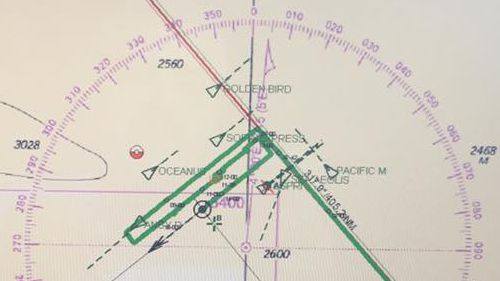Merchant Ships Join in Search for Missing Jet

Multiple merchant vessels in the Mediterranean diverted on Thursday to help in the search for the missing EgyptAir Flight MS804.
Among the earlier media reports of the aircraft's disappearance, Britain's Daily Star reported that the captain of an unnamed merchant ship had claimed sighting a "flame in the sky" in the vicinity of the aircraft's last known location.
At least one commercial ship has reported locating potential evidence of the aircraft's fate. Tarek Wahba, captain of the Maersk Ahram, posted digital photos to social media showing what he believed to be a life jacket; he also said that "wreckage of a plane seat" was found. The reports were not confirmed, and EgyptAir has since announced that the debris found to date is not related to its aircraft.
Wahba also posted ECDIS imagery showing a search pattern trackline adjacent to multiple other merchant ships, including the Pacific M, Golden Bird, Sofia Express, SE Pacifica and others.
As of 1800 EST, the Sofia had resumed a speed of 20 knots and a heading westbound in the direction of the Strait of Gibraltar. Other vessels also appear to have departed, but the Ahram was still in the vicinity of the search area.
A Greek frigate reportedly discovered two objects in the vicinity of a received transponder signal 230 nm southeast of the island of Karpathos – roughly the vicinity of the Maersk Ahram – that Greek forces initially believed to be related to the missing aircraft. However, subsequent reports have cast doubt on whether the objects recovered were related to the crash. An EgyptAir official told media Thursday afternoon that the objects found were not part of its plane, contrary to the airline’s earlier statements.
66 people were on board the flight, EgyptAir said, including French, Egyptian, British and Iraqi nationals, among others.
Authorities are still investigating possible causes, but several commentators point to human actions. Aircraft do not generally encounter trouble at the altitude of the flight's last moments "without human intervention," said aviation expert Richard Aboulafia, vice president of analysis at the Teal Group, speaking to the LA Times. "You have to go back decades to find anything at that altitude happening without human intervention."
John Goglia, a former US National Transportation Safety Board member, told the Associated Press that early evidence suggested a bomb rather than an equipment failure.
"Given the fact that [the pilot] made those abrupt turns without broadcasting any maydays would indicate to me that something catastrophic like a device happened," he said.
However, officials from multiple U.S. agencies told Reuters that a U.S. review of satellite imagery so far had not produced any signs of an explosion aboard the EgyptAir flight.
The U.S. officials, who spoke on condition of anonymity to discuss intelligence matters, said the conclusion was the result of a preliminary examination of imagery and cautioned against media reports suggesting the United States believed a bomb was responsible for the crash.
They said the United States has not ruled out any possible causes for the crash, including mechanical failure, terrorism or a deliberate act by the pilot or crew.
